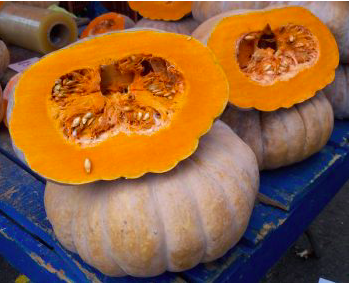During the last quarter of the year, the rains in most regions of Costa Rica are often overwhelming, particularly for gardeners. Even so, there are hardy plants that grow well in rainy conditions. One such plant that is perfect for “fall” is called ayote in Spanish, Cucurbita maxima is the native pumpkin squash of the tropical Americas. Grown in Costa Rica by indigenous tribes for ages before the Europeans arrived, these hardy native plants are still one of the most important staple crops of the region. Resistant to insect attacks and plant diseases, they are easy to grow in the home garden, and available at most local farmer markets called ferias.
Ayote
Ayote – Ayotes , from the squash family, can be eaten tender or mature. When eaten tender, you can prepare them the same as you would a yellow summer or zucchini squash, eating the peel, seeds, and all. Costa Rican cooks prepare a tasty dish called Guieso de Ayote. It is a simple stew that is made exactly like picadillo de chayote (substiting the ayote for the chayote) and adding cream at the end of the cooking process.
Ayote Sazon - Chinese Pumpkins
Meanwhile, mature (sazon) Ayote Sazon is prepared and used in the same manner as you would use a pumpkin. Many housewives prepare a cream de ayote or cream soup just like cream of pumpkin soup. It can also be candied by peeling the ayote, cutting it up into chucks and cooking it with water, cinnamon, and tapa dulce (molasses sugar) which makes for a sweet treat that is eaten as dessert. You can also use sazon ayotes in any recipe calling for pumpkin, including pumpkin pie.
Instant Pot Ayote Purée for Pumpkin Pie
Makes about 72 ounces (9 cups) purée
1 1/2 cups water
1 Ayote Sazon
Wash and dry the Ayote Sazon. Place it on a cutting board with a damp dish towel underneath. (The towel prevents the board from slipping.) Using a serrated or paring knife, cut into quarters, remove seeds, like you would for pumpkins.
Set a wire rack in a 6-quart or larger electric pressure cooker. Add the water. Place the pumpkin cut-side up on the rack. Set the cook time for 6 minutes at high pressure. (If you over cook it, it will be much more challenging to remove from the rind.)
When the cooking time completes, allow the pressure cooker to naturally release pressure (up to 15 minutes, 10 min is better). Open the pressure cooker and check the texture of the pumpkin. The pumpkin flesh should be fork tender. If it's not, cook for 2 minutes more at high pressure, repeating the natural release. Transfer the pumpkin to a cutting board until cool enough to handle. Once it is cooled, scrape the Ayote flesh away from the skin.
Option 1) Transfer the ayote to the bowl of a food processor fitted with the blade attachment blend until smooth, about 1 minute. Place in the strainer or colander. Using the back of a spoon, press on the pumpkin firmly to remove excess liquid (you can save the liquid to bake with later in Ayote breads and such).. Set aside to drain for 1 hour. Measure into 16-ounce portions, about 2 cups each. If any pumpkin remains, use it in smoothies.
Option 2) I use our Vitamix Blender. it takes about 10 seconds. I add some of the water from cooking the Ayote Sazon to the blender, and then I measure it in 2 cup amounts without letting it drain. And I freeze them in 2 cups in baggies in the freezer. It has worked fine, and I just try to get it to an apple sauce texture. I do like it cook a little extra in the oven.
Recipe Notes
Storage: Keep the purée in the refrigerator for up to 2 days, or place the fully cooled purée into a plastic freezer bag. Flatten and freeze for up to 3 months. Thaw in the refrigerator overnight before using. I also have used the double boiler method to quickly thaw the frozen puree.
Using like canned pumpkin: 1 (16-ounce) batch of homemade purée is equivalent to 1 (15-ounce) can pumpkin purée.
Directions for baking the seeds
Seed the Ayote: Preheat the oven to 300 degrees F. Using a spoon, scrape the pulp and seeds out of your pumpkin into a bowl.
Clean the seeds: Separate the seeds from the stringy pulp, rinse the seeds in a colander under cold water, then shake dry. If you choose to blot with paper towels, the seeds will stick, but you can easily pull them off of the paper towel.
Dry them: Spread the seeds in a single layer on an oiled baking sheet, or one lined with parchment paper and roast 30 minutes to dry them out.
Add spices: Toss the seeds with olive oil (optional), salt and your choice of spices. Return to the oven and bake until crisp and golden, about 20 more minutes.
Or if you like them sweet, toss with cinnamon and sugar (do not use salt in step 4).
http://www.ticotimes.net/2010/09/18/delicious-ayote-grows-well-in-rainy-season
http://www.welovecostarica.com/cooking-in-costa-rica-how-to-prepare-those-strange-vegetables-you-find-at-the-feria/
https://www.foodnetwork.com/recipes/food-network-kitchen/pumpkin-seeds-recipe-2105941








